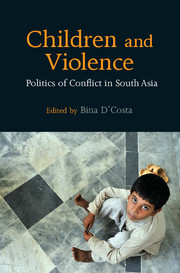Book contents
- Frontmatter
- Dedication
- Contents
- List of Map, Figures and Tables
- Acknowledgements
- Introduction: ‘Turtles Can Fly’: Vicarious Terror and the Child in South Asia
- Part I Shaping Childhood in South Asia
- Part II Conflict and Violent Peace
- Part III Rights, Needs and Protection
- Part IV Reflections from Human Rights Advocates in the Region
- Bibliography
- Notes on Contributors
- Index
Part II - Conflict and Violent Peace
Published online by Cambridge University Press: 05 June 2016
- Frontmatter
- Dedication
- Contents
- List of Map, Figures and Tables
- Acknowledgements
- Introduction: ‘Turtles Can Fly’: Vicarious Terror and the Child in South Asia
- Part I Shaping Childhood in South Asia
- Part II Conflict and Violent Peace
- Part III Rights, Needs and Protection
- Part IV Reflections from Human Rights Advocates in the Region
- Bibliography
- Notes on Contributors
- Index
Summary
In his analysis of military dictatorships, human rights abuses and extreme poverty in Latin American countries, David Mares suggests that violent peace is
the use of officially sanctioned military violence across national boundaries when war is not the intended result. War might occur, but as a result of escalation dynamics unknowable, unforeseen, or miscalculated by those who made the initial decision to use military force. …the decision to use military force should be thought of as a bargaining tactic rather than a decision to settle an interstate dispute through war.
The intricacies of objective political transition, healing and reconciliation for communities and economic recovery are all closely interlinked with a wide range of other security dynamic such as defusing spoilers of the peace process, integrating various factions, unprejudiced and appropriate demobilization of former combatants and resettlement of conflict-induced displaced population.
In the second part, ‘Conflict and Violent Peace’ the authors stress that securitization and displacement are the two major factors contributing to political instability in South Asia. The authors argue that intense presence of the state security forces and the perpetual fear and insecurity of children, women and men make it imperative to examine the region as one of ‘violent peace’. The impact of armed conflict on children in particular extends much further than those killed as a direct result of violence. Kabita Chakma and Glen Hill's chapter on children from the indigenous CHT, who were sent overseas for adoption, provides a humane narrative of such long-term impact of conflict. Amarnath Amarasingam and Tanuja Thurairajah's chapter on Sri Lankan migration reveals, how ‘the war’ is constantly present in the lives of refugee and immigrant children and in their everyday resistance. Youth, defined by the UN as between 15 and 24 years of age, is affected by the armed conflicts in a variety of different ways. While they can be formidable assets in innovation and creativity, able to promote equality and justice in the society, they can also be perpetrators of violent crimes. Swati Parashar and Zahid Shahab Ahmed's chapters on the Maoist insurgency in India and the terrorist networks in Pakistan provide insights on children's roles as subjects and participants in South Asian conflicts.
- Type
- Chapter
- Information
- Children and ViolencePolitics of Conflict in South Asia, pp. 103 - 106Publisher: Cambridge University PressPrint publication year: 2016



